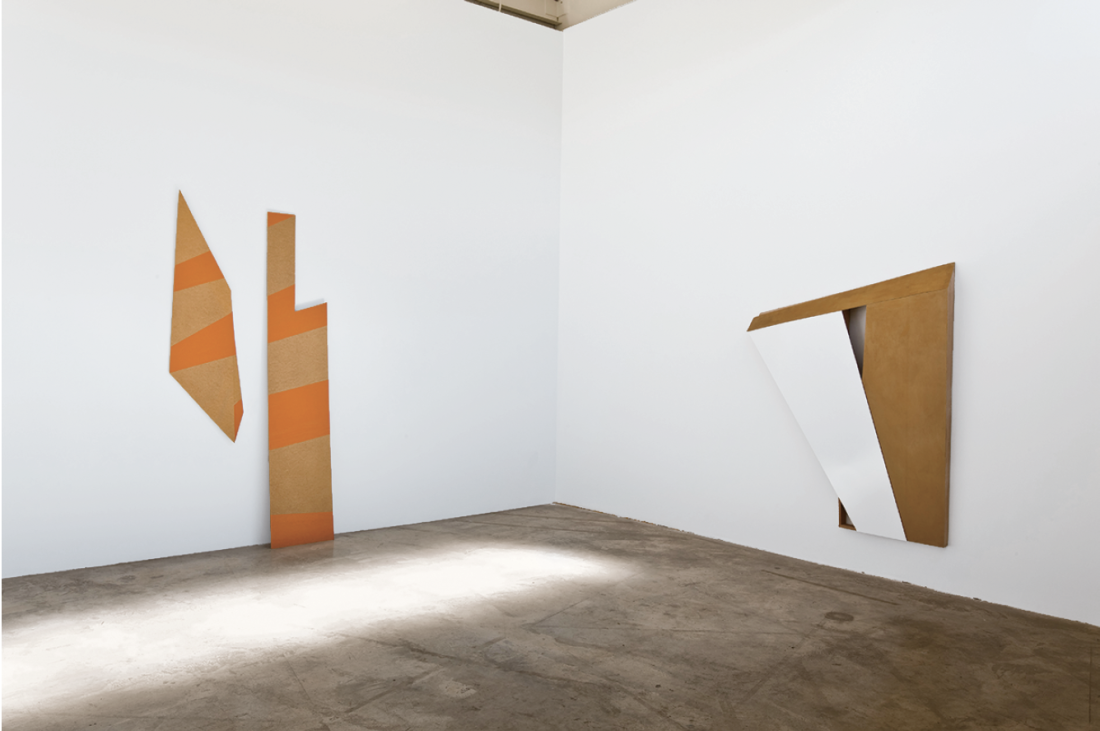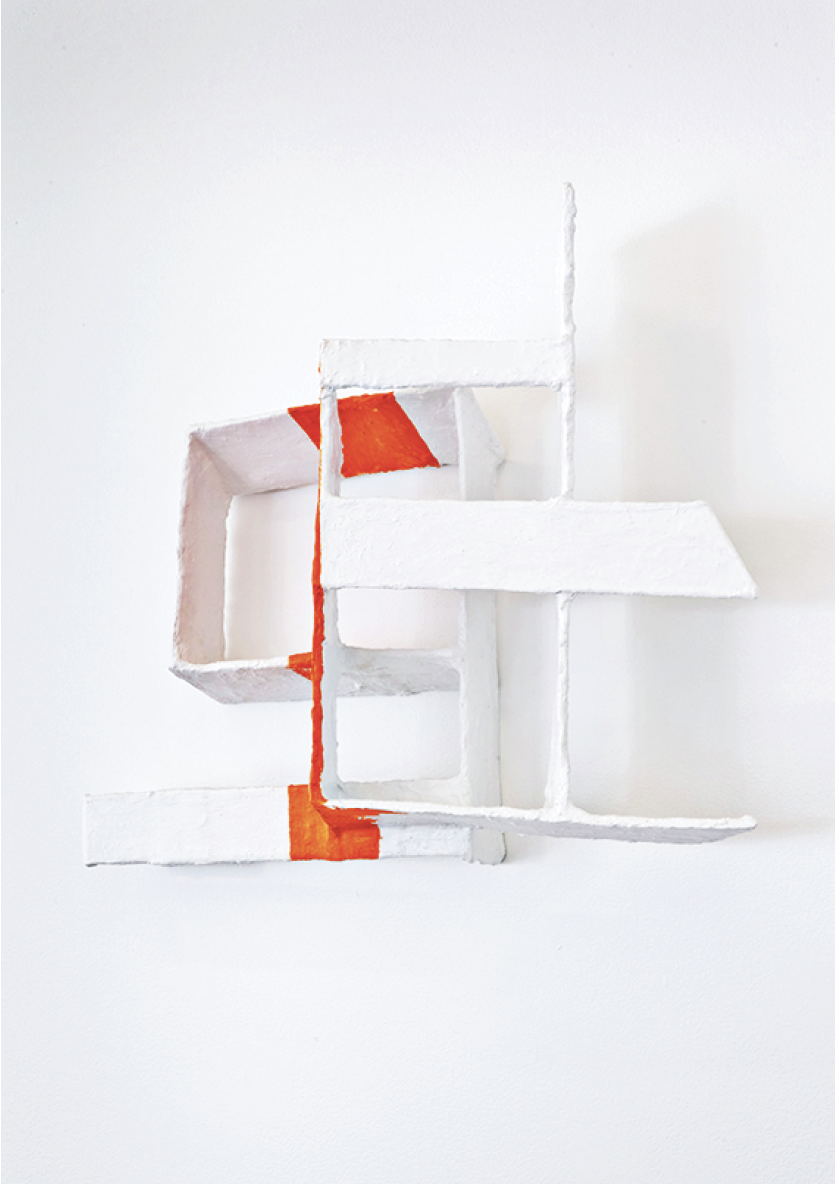Elspeth Pratt
The works of Vancouver-based artist Elspeth Pratt claim and inhabit the essentially provisional, often- ramshackle spaces available among the morphological conventions of free-standing sculpture, wall-supported sculpture, relief-sculpture, installation and environmental work and architecture per se.
An engagingly heterodox mix of outcast, abject, Arte Povera materials, arranged in ingenuously designed and juxtaposed configurations, Pratt’s work—especially the work making up “Outside in,” her recent exhibition at Toronto’s Diaz Contemporary—feels like an amalgam of Carpenter Gothic scavenging and the exertions of historic Modernism, particularly constructivism and minimalism, albeit guided by budgetary constraints.
There is an almost Tatlin-esque formal forcefulness to some of her pieces (see his counter-reliefs from c 1910). Others offer a whiff of Rodchenko-like elegance (see his cardboard Spatial Construction No. 5 from 1918, or his Construction No. 17 from 1921—in black and coloured crayon on paper). Nevertheless, Pratt has always made it abundantly clear that her sources are not to be found primarily within the realms of art history, though she does admit to an admiration for Eva Hesse, but are to be discovered within the modalities of contemporary social space.

Installation view of Elspeth Pratt’s “Outside in,” Diaz Contemporary, 2011, Photograph: Toni Hafkenscheid. Courtesy of the artist and Diaz Contemporary.
She draws her neo-constructivist language from fluid, semi-public spaces such as airports, shopping malls and museums, espousing a special alertness to our culture’s marginalized, peripherally located structures. As critic Robin Laurence noted in The Georgia Straight for February 28, 2008, about Pratt’s exhibition “Nonetheless” for the Emily Carr Institute’s Charles H Scott Gallery, “The marginal buildings that serve as the departure point for many of the sculptures in ‘Nonetheless’ are the improvised housing found in favelas, the shanty towns that have grown up simultaneously on the edges of cities and large towns in Brazil and other South American countries.” Pratt tells Laurence that she is “interested in the kind of architecture that develops at the outskirts—not the regulated architecture, but often what’s generated by people who have no choice.”
While it seems to me that scarcely anyone anywhere has much choice about anything these days, I sort of know what she means about an outskirts mentality. The work in the Diaz “Outside in” exhibition, if not exactly “unregulated,” does seem disarmingly castoff, rather as if the pieces now on or near the gallery walls had simply been left behind after some more deliberate body of work had been shipped off.
But it would be interesting to know the degree to which Pratt values and thus permits the subtle impress of some innate elegance within her to tweak her works into their final shapes. I say this because, while her pieces may indeed look disarmingly casual, there’s never anything robustly cruddy about them. In fact each of them luxuriates in sculptural tact and seems positively genial about its ability to proceed so authoritatively from one finessed moment to the next.
Take Cooper’s Quay, for example. It consists of two flat, shaped, hardboard elements: a tall one that is notched and leans against the wall and a second, smaller element that is very nearly a parallelogram and hangs high enough up so that the tops of both elements end by being at the same height. Both pieces are made of the same hardboard, and both sport parallel-running bands of bright orange enamel across them, like stripes on a tie.

Elspeth Pratt, Done Deal, 2010, cardboard, hydrocal, paint, 17 x 24 x 5.” Photograph: Toni Hafkenscheid. Courtesy of the artist and Diaz Contemporary.
I don’t know if there is an actual Cooper’s Quay nestled beside an ocean somewhere (I expect there is), but the fact is that because the two-part work is now necessarily contextless, both socially (who was “Cooper”?) and geographically speaking (where is the “Quay”?), we are thrown back upon the “pure” concerns touching on shape, colour, materiality, placement, adjustment, proximity, distance and morphological memory-in-the-present (where have we seen these shapes before—or have we really?). What it comes to is that, in the end, Cooper’s Quay is an almost overwhelmingly self-conscious, sheerly aestheticized work. Rough-hewn though it might be.
Portico, though more Stella-like in shape than any of the other works (a sheet of mahogany-hued, waxed mdf and a sheet of gleaming white shower board end up by creating together a bi-valve trapezoid on the wall), gets further into the freshness of abjectness with its fully disclosed comparison of hardware-store materials than Cooper’s Quay does with its orange stripes. But like Cooper’s Quay, Portico is also inescapably memorial—powerfully reminiscent of this and that in Modernism’s formalist past. The work is, however, a clean, cheekily cheerful bit of assemblage—and maybe that’s enough.
But I bet it isn’t enough for Elspeth Pratt. Because there are better things in “Outside in” (though the cleverness of this reversible title is beginning to get me down a little) than Cooper’s Quay and Portico.
There is Done Deal for example. Done Deal is a bracingly slapdash cardboard construction (though “construction” is really too solid-sounding a word for this creaky looking shelf-unit—for that is what it most resembles). This shelf-like object has been so heavily brushed with hydrocal that it looks muffled by the resulting whiteness. The soft, heavy whiteness of the work has then been enlivened by the addition of bright orange paint, employed to give extra energy to a sustaining, load-bearing, vertical member located more or less at the piece’s middle point. The entire work now seems to droop a bit on either side of this upward orange thrust—the way long, heavy wings droop on either side of an ancient biplane’s fuselage.
What is so satisfying about Done Deal? The way it so stubbornly and placidly rests upon its own engaging awkwardness. Done Deal is, I think, the best thing in “Outside in.” Why? Because it doesn’t look like anything else I can remember having seen. There are perhaps faint echoes in it (like music from next door) of objects by Joseph Beuys, by Dieter Roth, by Richard Tuttle. But these are adjacencies, not forebears. Done Deal is really rough and really rough is really best for Pratt; it is a sort of anodyne for the wound of her slickness. ❚
“Outside in” was exhibited at Diaz Contemporary in Toronto from March 26 to April 23, 2011.
Gary Michael Dault is a critic, poet and painter who lives near Toronto.

